Red Sea
Eritrea Sudan
Egypt
Egyptian Antiquities
Petra Jordan

Bab el Mandeb
The passage from Aden in the Indian Ocean to
Eritrea in the Red Sea would first take us through the Straits of Bab el Mandeb.
Known as the Gate of Sorrow or Gates of Tears, the gates are a narrow
funnel where the Red Sea empties into the Indian Ocean. The land on one
side is Yemen on the Arabian Peninsula and on the other is Djibouti in Africa.
We timed our arrival at the gates for sunrise when the wind might be the lightest but we still had a solid 25 knots. Fortunately it was behind us giving us a fast and relatively comfortable passage. When we got to the gates the current surging up through the narrow straits boosted our speed from our normal 6 knots up to nearly 9 knots for a few minutes.
For the next few days we island hopped northwards in Eritrean waters towards the town of Massawa. This included stops where we hiked up an ancient volcano. This time of year the Southern Red Sea almost always has southerly winds which would be behind us, but luck seemed to be against us as after a few days we encountered north winds.
On a Lee Shore
To make matters worse the winds changed from South to
North about 8 pm one evening and our calm anchorage on the North side of one
island suddenly became a very dangerous place as the wind howled down unimpeded
directly onto us pushing our boat towards the rocky shore. By 10 pm the
boat was pitching in 3 foot waves and if we dragged anchor we would lose the
boat in minutes on the jagged cliffs behind us. I had been aware of
the possibility of this happening and had another anchorage already in mind,
but pulling up anchor in these conditions in the dark and motoring 16 miles then
entering the other anchorage also in the dark was very risky but we had no
choice.
Near Disaster
In the lectures I have given on sailing, or
expedition mountaineering I have often made the point that it is rarely the
first problem that causes disaster. It is usually one problem that leads
to another problem that leads to a third problem which can lead to disaster.
For example the boat's autopilot might break forcing you to hand steer.
This means you do not get enough sleep. Then in your exhausted state you
make the navigational mistake that puts your boat on the reef. In
flying small planes it is much the same and they actually now teach you how to
recognize the chain of mistakes- interrupt the chain and you save the day.
Instead of steering until you are exhausted just heave to where the boat will
take care of itself unattended for awhile and sleep.
We were about to have a chain of mistakes that could have led to disaster- and it was as much luck as my interrupting the chain that saved the day.
Before we had left Thailand I was aware that my feathering propeller was old and the gears were a bit loose and sloppy. Nothing too serious but I did look into getting a spare propeller in Thailand. Unfortunately it was not readily available so I departed without one. (Mistake 1). From Thailand to Aden we had motored quite a bit because of the light winds so the propeller got more use than expected. As we progressed the propeller began rattling causing engine vibrations. If I was attentive I could feel the vibrations, and then alter the rpm to get the vibrations to stop. Unfortunately several times over the next months I was not attentive and went long distances with the engine vibrating excessively. (Mistake 2). In Aden I noticed I had a broken alternator mount, which we had welded. This break was caused by the vibrations. Later I was to discover not only was the mount broken but the alternator had vibrated enough to short out its diodes. From then on we had only one alternator to charge our batteries instead of two. (Another link in the chain).
Not only had the alternator bracket broken but engine vibrations had loosened the flange that holds the propeller shaft where it exits the boat and that began to leak. All boats leak a bit and our bilge pump normally comes on once every few weeks and pumps out a gallon or two of water. Now in Aden the pump was coming on once every two hours for 30 seconds or so. Nothing serious but it would certainly bear watching. It would have delayed us and been a big headache to ship in a new propeller from the US to Aden but it could have been done.- I didn't ship one. (Mistake 3).
From Aden to the next place we could get real boat work done would be nearly 1,000 miles. Yet we departed Aden with a leak that was not fixed and was bound to get worse over time and with a propeller that also could only get worse. Certainly not the best decisions I had made in my life.
About a week after leaving Aden the bilge pump was coming on every hour. Then a few days further on as we approached Massawa I heard a very small backup shower pump come on which is unusual and would only happen if the bilge pump quit and water overflowed into the shower sump area. When I looked below I saw the leak had grown tremendously and water was gushing in. To make matters worse the main bilge pump was not working at all. It was not time to panic yet but things were suddenly pretty serious. The chain of my mistakes had caught up with me.
I quickly instructed Dee to shut off the engine so the prop shaft leak slowed to a trickle and to start pumping with the hand pump. Meanwhile I plugged in an emergency bilge pump I had rigged up years ago and have never needed to use. Luckily the backup bilge pump did the job and I was glad I had gone to the extra trouble to install one. We continued towards Massawa under sail alone, only starting the engine long enough to enter the harbor and tie up to the rough concrete wharf.
Later we were to discover that the bilge pump had failed because it was wired to my small engine starting battery rather than my large house battery- something I should have changed years ago.
Sailing as we do is a mix of bobbing at idyllic anchorages with no cares in the world one day and putting yourself to a major test of resourcefulness with your lives at stake the next day. And always we try to learn from our mistakes and do better next time.
When I first started cruising I remember someone once telling me that every time you get up in the middle of the night to check the anchor, or double check the engine, or go up the mast to verify the rigging or perform any of those dozens of extra tasks that a conscientious sailor does, you are depositing credits in an account that you can draw on when the chips are down and luck is against you. Clearly rigging up an extra bilge pump was one of those extra deposits that I had just cashed in.
Now we were faced with the dilemma of how to fix the propeller and the leak in a place with virtually no facilities for yachts. I was terrified of trying to haul the boat out of the water with a construction crane if such a thing even was possible. My first step was to enlist the help of cruising friends who are far more knowledgeable than I am. Especially helpful was our friend Charlie Johnson of Bearboat. Charlie is an ex navy officer who had once been in charge of repairing US Navy submarines. There is simply nothing marine he does not know. With our friends' advice via email, and after spending lots of time under the boat with scuba gear I was able to stop the leak without hauling the boat out of the water. That was a huge relief, leaving only the propeller issue to solve.
Ventana's propeller is a special type that feathers when under sail. This means the blades twist when sailing so only a very thin edge is exposed to the water thus creating almost no drag. When under power the blades spin into position for either forward or reverse. My friends and other experts had approved my idea to weld the propeller in one position so it could not vibrate. I took the prop to be welded and had they just welded it as I requested the story would happily end there-- we were not to be so lucky.
The crew at the ship yard decided against my advice to open up the prop and check if it could be fixed first. I knew the gears were simply worn out and no fix was likely. Unfortunately they opened it up without marking how every part came out and then putting it back together became a guessing game. There was no way to be sure we had the correct pitch on the prop. Over the next week I was to spend hours and hours under the boat with scuba gear to remove and re-install the prop five times as they kept trying to get it right. Each time they would weld it in place sure they had it right and then be forced to grind the welds off further damaging the prop. All of this was done with a tremendous language barrier in a place that had virtually no facilities. Finally we departed Massawa with a prop that we thought would work OK. Within hours we realized they had welded it into a position that did not have enough pitch and we could only go very slowly. Against strong winds we would not be able to proceed at all.
After a week of frustration and expense in Massaawa we were not much better off. The leak was stopped but the prop situation was not resolved. This was to haunt us as we proceeded northwards to Sudan.
As for our time in Massawa there is not much to say. The town looks like the war zone it is with bombed out buildings everywhere and the people very poor. Some cruisers went to the capital city of Asmarra in the hills a few hours away and enjoyed street cafes serving cappuccino and other reminders of the Italian colonial period.
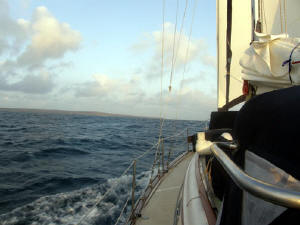
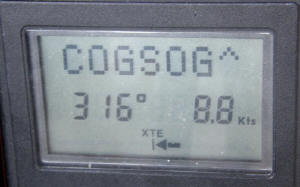
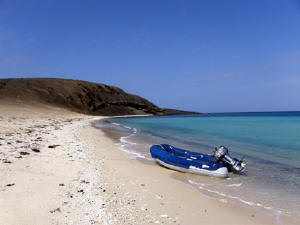
Approaching Bab el Mandeb
Current helping us along
Islands off Eritrea
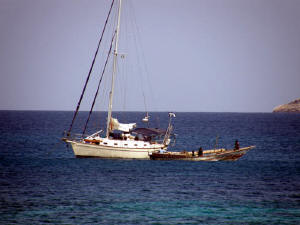
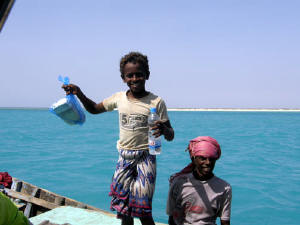
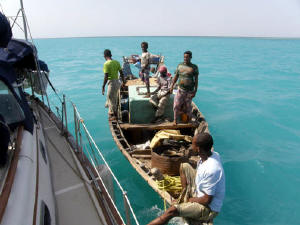
Eritrean fishermen would often come by to trade fish for anything. Dee
gave them fresh baked bread or I provided fishhooks, lures, batteries
or whatever we could spare. In the photo below right I am trying to fix a
pump from their boat as they did not even possess a screwdriver.
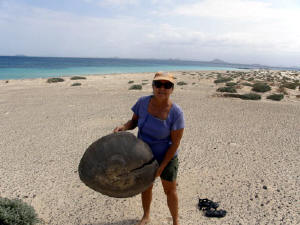
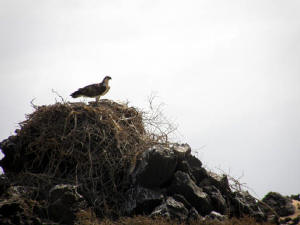
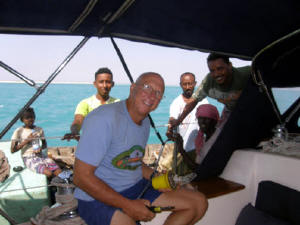
Dee with a turtle shell we found. We saw ospreys, flamingoes, goliath
herons, spoonbills and more.
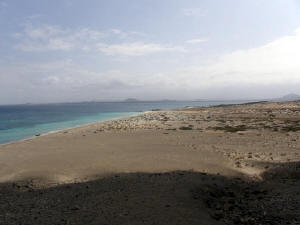
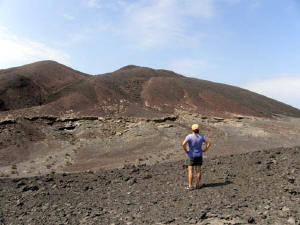
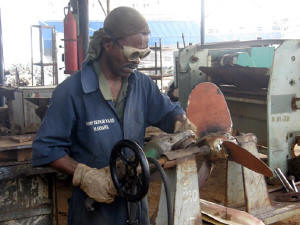
Stark
Landscape
Welding the propeller
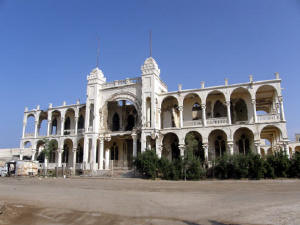
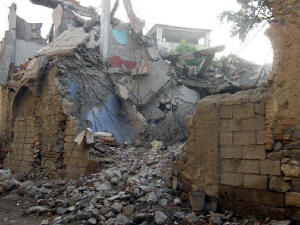

Bombed out building
Bombed out building
The women were covered but not all in black



















